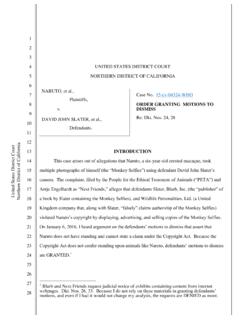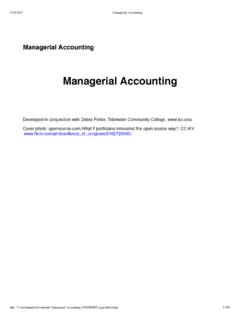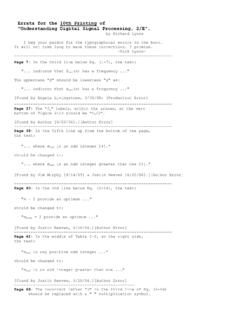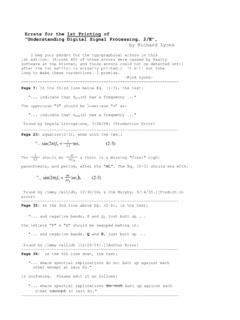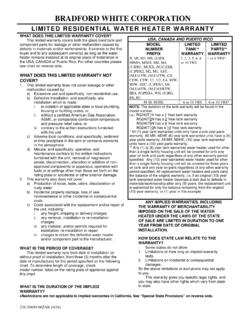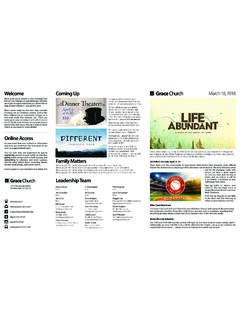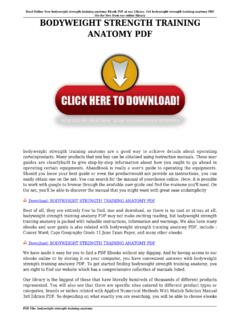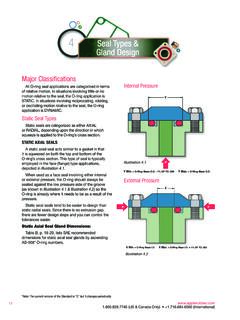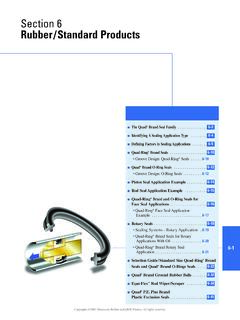Transcription of PTFE Rotary Lip Seal Guide - s3.amazonaws.com
1 Brought to you byPTFE Rotary Lip seal Guide3 Question? Seals ContentIntroduction ..4 History ..7 How They Work ..8 Why PTFE ..10 Fillers Employed with PTFE Resins ..12 PTFE Radial Lip seal Design ..19 Design Principles Employed in PTFE Radial Lip seal Design ..23 PTFE Rotary Lip seal Definitions ..26 Housing and Bore Considerations ..32 Pressure and Shaft Velocity ..33 Shaft Misalignment and Runout ..34 Application Areas for PTFE Radial Lip Seals ..37 Application Data Sheet ..415 Question? Low friction Long seal life with proper configuration Strong chemical resistance Surface speeds up to 10,000 feet per minute Wide temperature range.
2 -65 F to 450 F (-53 C to 232 C) High pressure in excess of 500 psi (35 bar) Extended seal life in dry or abrasive media Unlimited shelf Life Large diameter capability Custom profile design Motors Gearboxes Pumps Bearings Compressors Cryogenics Extruders Valves Blowers Spindles Robotics MixersA PTFE Rotary Lip seal is a seal that features a lip on the ID that seals dynamically on a shaft and metal casing on its OD to press-fit into a bore. A gasket is sandwiched between layers of sealing lips and the can to seal off the potential leak path.
3 Since the lip is not spring-energized, the radial lip contact forces are lower than a Rotary spring energized PTFE seal , which allows the seal to function at much higher surface speeds (up to 10,000 sfpm).The seals are manufactured from a wide variety of PTFE composites and other machinable plastic materials. Standard gasket choices are fluorocarbon, nitrile, EPDM, and Armstrong reinforced Engineer can choose between stainless steel, cold rolled steel, zinc-plated cold rolled steel and aluminum. This broad foundation of standard gasket, metal and PTFE materials can be tailored to suit nearly all applications.
4 Standard and Non-standard seal profiles are precision machined to fit inch and metric gland geometries. PTFE Rotary lip seals are used in demanding applications where the operating conditions exceed the capabilities of elastomeric seals. What is a PTFE Rotary Lip seal and How Does it Work?Features / BenefitsApplications7 Question? The discovery of PTFE (polytetrafluoroethylene) resin dates back to 1938, but it was not until the 1950 s that PTFE gained considerable attention as a possible material for Rotary lip seals. Unfortunately, during the 1950 s and 1960 s PTFE seals proved to be inconsistent and unreliable performers in many applications.
5 In more recent decades, however, there has been significant progress made in the areas of PTFE lip seal design and material processing. The following is aimed at providing the application engineer with a better understanding of PTFE as a material, some insight into the seal design and manufacturing practices, and a background on applications where PTFE has proved to be an excellent radial lip seal compound. The successful application of PTFE radial lip seals is dependent upon a thorough understanding of the basic properties and functional characteristics of PTFE resins, and in turn applying these criteria to the areas of product design and manufacturing methods.
6 The PTFE lip seal provides to the end user; a sealing device that is compatible with virtually all fluids and additives, functional throughout a broad temperature range, and a low wear-rate enabling it to exceed today s required warranty History9 Question? Rotary shaft seals work by squeezing and maintaining the lubricant in a thin layer between the lip and the shaft. Sealing is further aided by the hydrodynamic action caused by the rotating shaft, which creates a slight pumping action Rotary shaft seals provide protection by performing two critical functions.
7 In most applications the primary function of the seal is to retain the bearing or system lubricant. There are thousands of different types of lubricants available today, but in general bearings are either oil or grease lubricated. The second function of the seal is to exclude outboard material that can contaminate the system lubricant or directly damage the bearing. The type of contamination the seal will need to exclude is dependent on the application. The more common types are moisture, water, and dry materials including dust, sand, dirt or particulates such as those generated by manufacturing processes.
8 The seal s ability to retain the system lubricant and exclude contaminants plays a key role in the service life of equipment components such as bearings, and gears and relies on the system lubricant. The seal can have a dramatic impact on the service life of the system lubricant, reducing exposure to excessive frictional heat and excluding foreign material. Typical petroleum oil has a useful life of thirty years at 86 F (30 C) if it is not contaminated with water or particulate matter, but the same oil has a life of only a month at 212 F (100 C).
9 As little as water in oil lubrication can reduce ball bearing life by 50%, primarily through How They Workhydrogen embrittlement. Solid particles cause more rapid damage to the bearing race through high-localized stresses and increased frictional heat. The sliding contact between the seal lip and the shaft will generate friction, increasing the contact temperature beyond the temperature caused by the bearings and other sources. Heat accelerates the breakdown of the oil and starts forming a varnish on the hot spots. Over time, the varnish changes to carbon and builds in thickness as the surrounding oil loses its lubricity.
10 How quickly this happens is dependent on temperature. The deposit can leak and abrade the lip, causing leakage. The time to reach each stage is cut in half for each 18 F (10 c) increase in temperature. The amount of frictional heat that is generated is a combination of many operating parameters. Shaft surface, internal pressure, operating speed, lubricant type, lubricant level, lip geometry and lip material are just a few of the conditions that need to be considered. It is important to note that these conditions are very interactive. For example, an increase in shaft speed will increase the sump temperature.



